
Minas Gerais is a state in Southeastern Brazil. It ranks as the second most populous, the third by gross domestic product (GDP), and the fourth largest by area in the country. The state's capital and largest city, Belo Horizonte, is a major urban and finance center in Latin America, and the sixth largest municipality in Brazil, after the cities of São Paulo, Rio de Janeiro, Salvador, Brasília and Fortaleza, but its metropolitan area is the third largest in Brazil with just over 5,800,000 inhabitants, after those of São Paulo and Rio de Janeiro. Nine Brazilian presidents were born in Minas Gerais, the most of any state. The state has 10.1% of the Brazilian population and is responsible for 8.7% of the Brazilian GDP.
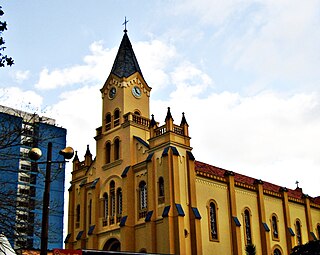
Manhuaçu is a municipality in Eastern Minas Gerais state, in Brazil. Its population was 91,169 (2020) and its area is 628 km².

Alterosa is a Brazilian municipality in the South of the state of Minas Gerais. According to latest data from IBGE (2020), its population is estimated to be 14,517. The inhabitants of the city usually travel to the nearest city, Alfenas, when they are in need of more sophisticated supplies.

Nova Lima is a municipality of about 87,000 people, whose downtown is located about 20 kilometers of Belo Horizonte, the capital of the south-eastern Brazilian state of Minas Gerais. Mining is one of the main economical activities of the city, including the extraction of Iron Ore and Gold. The most famous mine in the city is Morro Velho, a gold mine of 2,700 metres (8,900 ft) depth.

The Jê languages, or Jê–Kaingang languages, are spoken by the Jê, a group of indigenous peoples in Brazil.

The Maxakalían languages were first classified into the Jê languages. It was only in 1931 that Čestmír Loukotka separated them from the Jê family. Alfred Métraux and Curt Nimuendajú considered the Maxakalían family isolated from others. John Alden Mason suggests a connection with the Macro-Jê stock, confirmed by Aryon Rodrigues.

The Mantiqueira Mountains are a mountain range in Southeastern Brazil, with parts in the states of São Paulo, Minas Gerais and Rio de Janeiro. It rises abruptly from the northwestern bank of the Paraíba do Sul River and extends northeastward for approximately 320 km (200 mi), reaching a height of 2,798 m (9,180 ft) at Pedra da Mina. The mountains, which eventually merge with the Serra do Espinhaço, were originally forest-covered, except for the peaks that rise above the tree line. They provide charcoal and pasture for cattle; on the lower slopes there are several health and tourist resorts, such as Campos do Jordão, Brazil's highest city. The name Mantiqueira derives from a Tupi word meaning "mountains that cry", denoting the large number of springs and streams found there.

Purian is a pair of extinct languages of eastern Brazil:
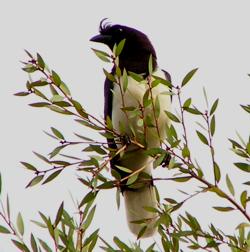
The curl-crested jay is a jay from South America.

Raposos is a Brazilian municipality located in the state of Minas Gerais. The city belongs to the mesoregion Metropolitana de Belo Horizonte and to the microregion of Belo Horizonte.
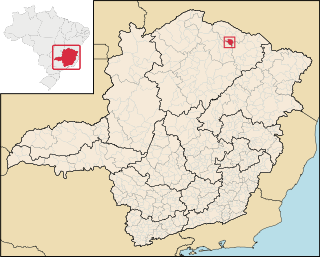
Mato Verde is a municipality located in the north of the state of Minas Gerais in Brazil. It was founded in 1953. The population was 12,412 as of 2020 and the area was 664 km². The elevation of the city is 541 metres. The postal code (CEP) is 39527-000.

Nova Porteirinha is a municipality in the north of the state of Minas Gerais in Brazil. The population in 2020 was 7,497 in an area of 121 km2 (47 sq mi). The elevation is 533 meters (1,749 ft). It became a municipality in 1997. The postal code (CEP) is 39525-000.
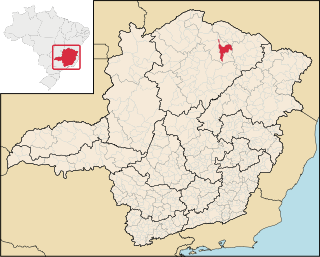
Porteirinha is a municipality in the northern region of Minas Gerais, Brazil. The population in 2020 was 37,864 in an area of 1,806 km². The elevation is 566 meters. It became a municipality in 1938. The postal code (CEP) is 39520-000.

Riacho dos Machados is a municipality in the northern region of Minas Gerais, Brazil. The population in 2020 was 9,476.

Serranópolis de Minas is a municipality in the northern region of Minas Gerais, Brazil. The population in 2020 was 4,809.

Rio Pardo de Minas is a municipality in the northeast of the Brazilian state of Minas Gerais. Its population in 2020 was 31,045 inhabitants in a total area of 3,117 square kilometres (1,203 sq mi).
The Pacuí River is a river of Minas Gerais state in southeastern Brazil. It is a tributary of the Gorutuba River.

The Kamakã languages are a small family of extinct Macro-Jê languages of Bahía, northeastern Brazil. The attested Kamakã languages are:

Serra do Gandarela National Park is a national park in the state of Minas Gerais, Brazil. It protects a mountainous region holding a remnant of Atlantic Forest that is an important source of water for the city of Belo Horizonte.
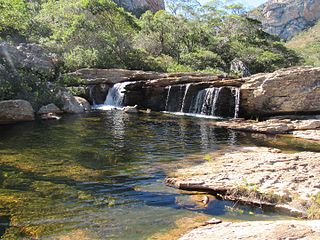
The Serra Nova State Park Portuguese: Parque Estadual de Serra Nova is a state park in the state of Minas Gerais, Brazil. It protects an area of rugged terrain with considerable diversity of flora and fauna.


















